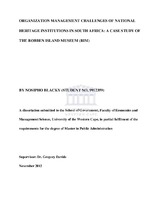| dc.contributor.advisor | Davids, Gregory | |
| dc.contributor.author | Blacky, Nosipho | |
| dc.date.accessioned | 2021-03-11T10:45:12Z | |
| dc.date.available | 2021-03-11T10:45:12Z | |
| dc.date.issued | 2012 | |
| dc.identifier.uri | http://hdl.handle.net/11394/7964 | |
| dc.description | Masters in Public Administration - MPA | en_US |
| dc.description.abstract | In January 1997, Robben Island Museum (RIM) opened its doors to the public as a tourist destination. This was done without any formal management structure or strategic planning, to cope not only with its mandate as the first National Museum of the new democratic South Africa, but also to meet the demand of the great interest of visitors to see this prison where the icon of the liberation struggle, Nelson Mandela was incarcerated for 27 years. This operational take-off without formal administrative management structure and strategic planning was understandable given the social and political transitional climate in the country. The effect thereof as the old adage states ‘failure to plan is planning for failure’ seems to hold true for RIM who is struggling to become a well-managed national heritage site. RIM over the years have been beset with governance and management challenges and enjoyed continual bad publicity. The study’s aim was to bring an understanding of what the major governance and managerial challenges were and to make recommendations to address those. The study was guided by a central research question namely What were the administrative and management challenges of RIM and in what ways did it impact on the operational effectiveness of RIM as a national museum and World heritage site. A number of findings emanated from the study. A key one was that clarity of roles and responsibilities of the council and the management is required. Furthermore, the vision and mission of RIM must inform the formulation of strategies to give effect thereto. This in turn must be the base for the development of an appropriate organisational structure to implement the strategies. A number of recommendation stems from the research. An important one was that appointment must be on the basis of ‘fit for purpose’. This means that staff with the right skills and capacity should be appointed as a matter of priority. In conclusion, the findings of the study could be used by other heritage organisations faced with similar organisational challenges. | en_US |
| dc.language.iso | en | en_US |
| dc.publisher | University of the Western Cape | en_US |
| dc.subject | Robben Island Museum | en_US |
| dc.subject | Strategic objectives | en_US |
| dc.subject | Governance | en_US |
| dc.subject | Organisational restructuring | en_US |
| dc.subject | Council | en_US |
| dc.subject | World Heritage Site | en_US |
| dc.subject | Heritage Institutions | en_US |
| dc.title | Organization management challenges of national heritage institutions in South Africa: a case study of the Robben Island museum (RIM) | en_US |
| dc.rights.holder | University of the Western Cape | en_US |

